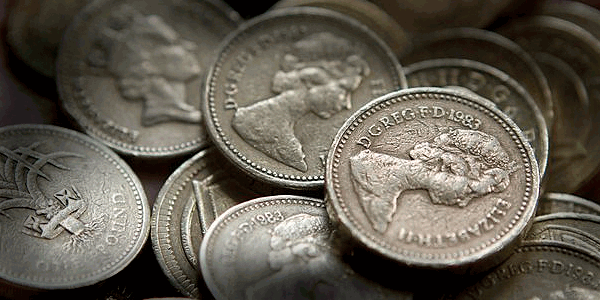 More than 30 years after The Royal Mint commenced production of Britain’s modern £1 coin, the last of the familiar gold-coloured coins rolled off the presses in December to make way for production of its new-look replacement, which will be brought into circulation in 2017.
More than 30 years after The Royal Mint commenced production of Britain’s modern £1 coin, the last of the familiar gold-coloured coins rolled off the presses in December to make way for production of its new-look replacement, which will be brought into circulation in 2017.
Traditionally, the design of the ‘round pound’ has celebrated the four parts of the United Kingdom, with England, Northern Ireland, Scotland and Wales each taking a turn to be featured on 24 different circulating designs depicting their capital cities, bridges, and national emblems as well as the Royal Arms of the United Kingdom.
Over 2.2 billion circulating round £1 coins have been struck during its 32 years of service to the British public, during which time it has witnessed many changes to our country, our environment and our lifestyle. Launched on Queen Elizabeth II’s birthday on 21 April 1983, its tenure has been viewed as a success, with the fact that 1983-dated coins can still be found in your change evidence of its durability far exceeding the nine-month lifespan of the £1 note that it replaced.
Royal Mint Coin Press Setter John Jones was working in the Circulating Coin Production team at the time of the launch, and recalls, “We were really proud when we got the £1 business, it was a feather in our caps to be striking it. Prince Charles came to strike the first one, and we all lined up to watch him arrive.”
On 19 March 2014 the Chancellor of the Exchequer, George Osborne, announced plans for the introduction of a new bi-metallic 12-sided £1 coin incorporating revolutionary security features aimed at combating counterfeiters, in line with The Royal Mint’s longstanding reputation for being at the leading edge of minting.
Chief Executive of The Royal Mint Adam Lawrence said: “The end of the round £1 is a significant chapter in The Royal Mint’s 1,000 year history, and I’m sure that many in Britain who have grown up with the familiar round coin will experience a certain amount of nostalgia when the last one comes off the presses.
“The Royal Mint is constantly looking to the future, however, so whilst the round £1 has served us well, it is time to turn our attention to the new £1 that in time will be used by millions of people in Britain and become equally well recognised across the world.”
The final farewell will come when the round £1 is withdrawn from circulation to make way for its replacement in 2017, when some may experience a sense of déjà vu – the 12-sided outline of the new coin is reminiscent of the pre-decimalisation ‘threepenny bit’.
Fascinating facts about the round £1
- The £1 coin was first issued 21/04/83 – the Queen’s birthday – the highest denomination coin in circulation at the time
- The £1 coin was issued during the tenure of the UK’s first woman Prime Minister, Margaret Thatcher
- There have been 24 circulating reverse designs since its introduction – many can be seen here
- The symbol, £, is derived from the first letter of the Latin word for pound, the librum
- £1 coin has a mint mark: a small crosslet found on the milled edge that represents Llantrisant in South Wales
- Growth in the vending industry was a factor in changing from the £1 banknote to the £1 coin
- The £1 coin has borne 4 portraits of The Queen during its 30 years
- The £1 is the only entirely ‘yellow’ metal UK circulating coin
- The £1 is the thickest UK coin in general circulation. Only the £5 coin is thicker but it is not in general use
- The first series of £1 designs were of floral emblems of the four UK countries
- The £1 coin has borne four depictions of the Royal Arms on its reverse
- In the current ‘decimal’ monetary system, £1 is worth 100 pence. In the pre-decimal system, £1 was worth 240 pennies
- It is illegal to spend or pass on a counterfeit £1, it should be taken to a police station
- £1 nicknames: a nicker, the ’round pound’, quid (“quid” being the most common and used for both note and coin)
- Announcement of the change from £1 banknote to coin was made in 1981, two years before issue
- The Royal Mint make £1 coins in platinum, gold, silver and proof finishes for collectors. You won’t find those in your change!
Coin Edge Inscriptions

Origins of the £1 coin
The origins of the pound coin can be traced to Tudor times, when Henry VII ordered the officers of his Royal Mint to ‘produce a new money of gold’. His Sovereign was first struck in 1489, and with a value of one pound sterling – the largest coin yet seen in England.
By the early 1980s it had become clear that £1 notes were no longer fit for purpose. They were expensive to produce and had a short lifespan, so it was time to introduce a more practical and cost-effective alternative. The modern pound coin entered circulation on 21 April 1983 – The Queen’s birthday – with the very first edition featuring a Royal Arms design by Eric Sewell, with the Latin inscription DECUS ET TUTAMEN – ‘An ornament and a safeguard’ on the coin’s milled edge.




